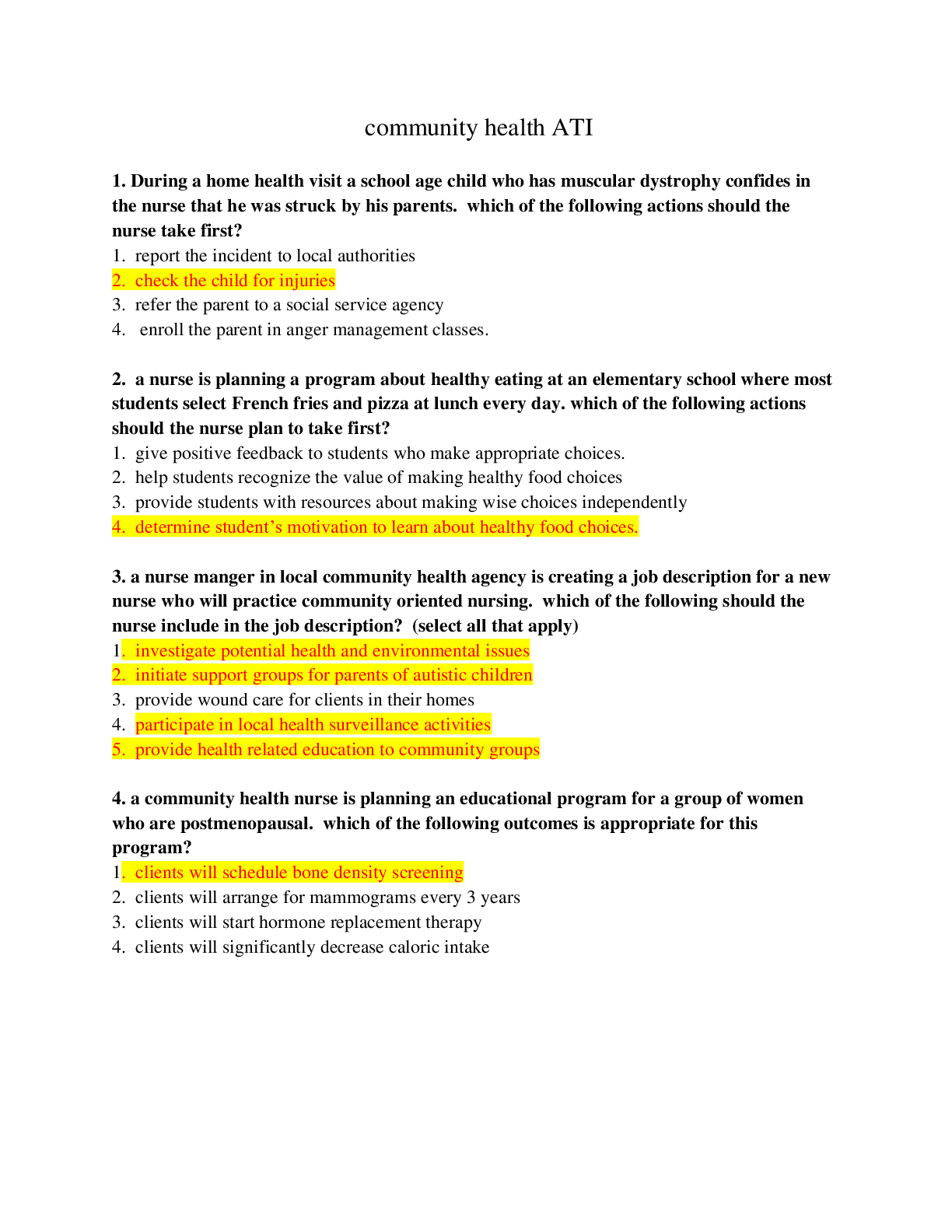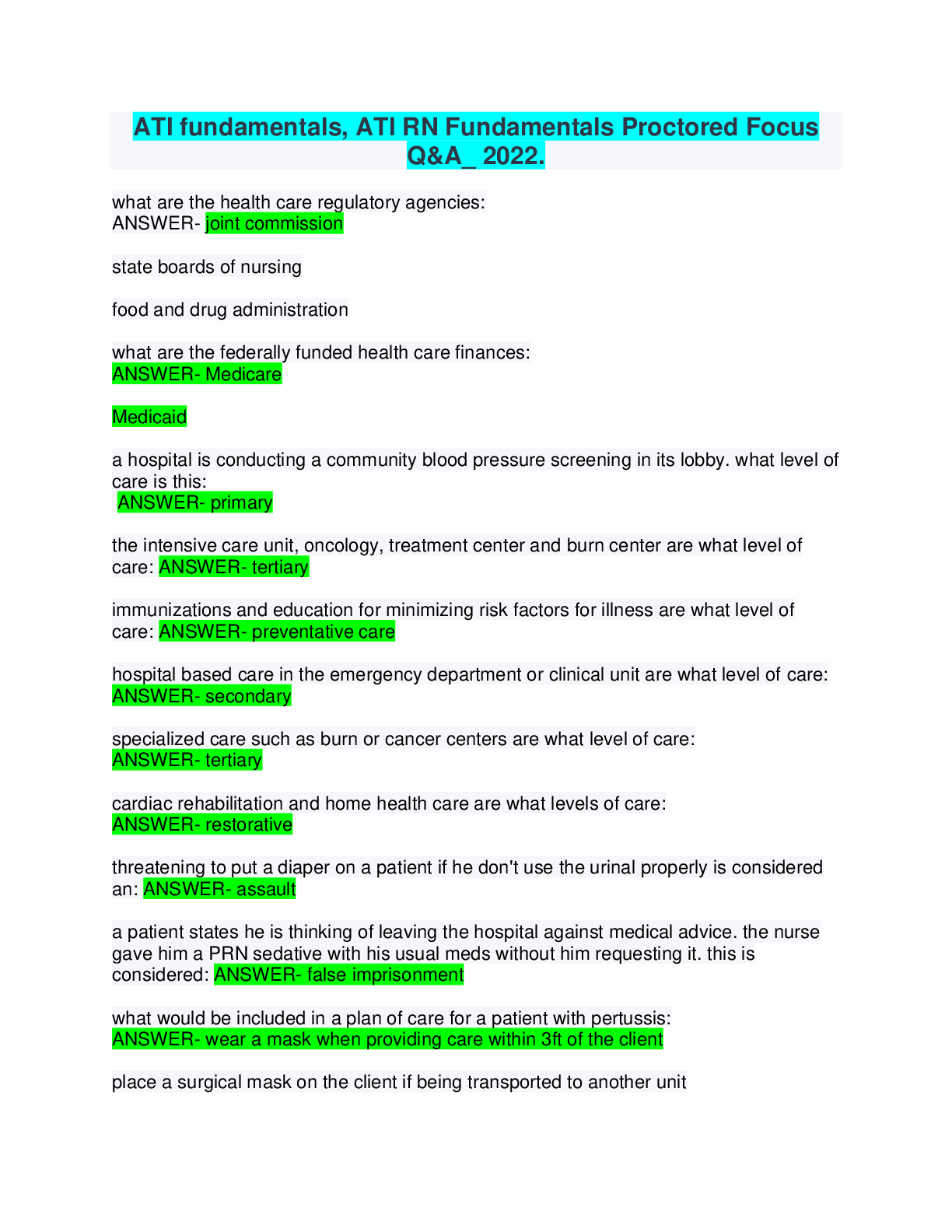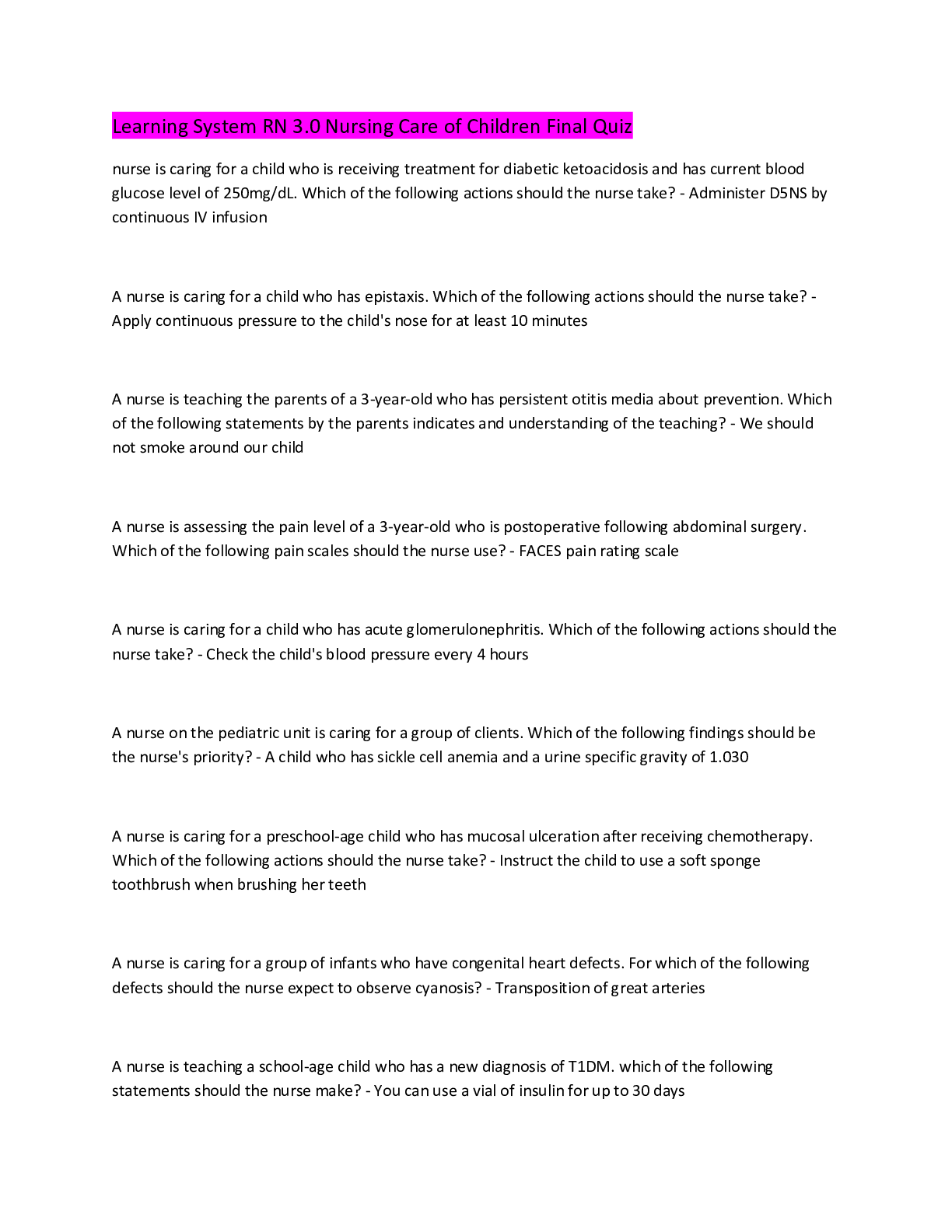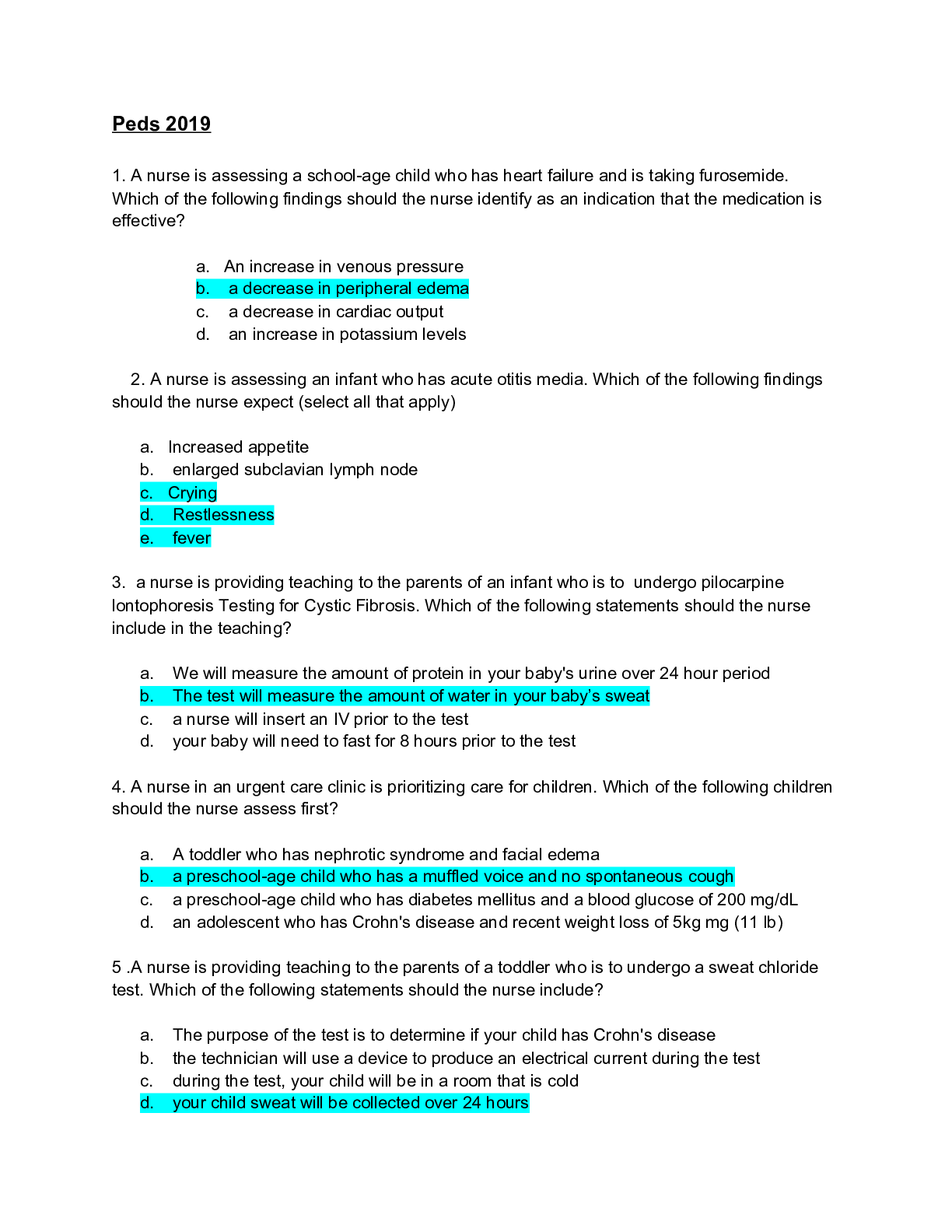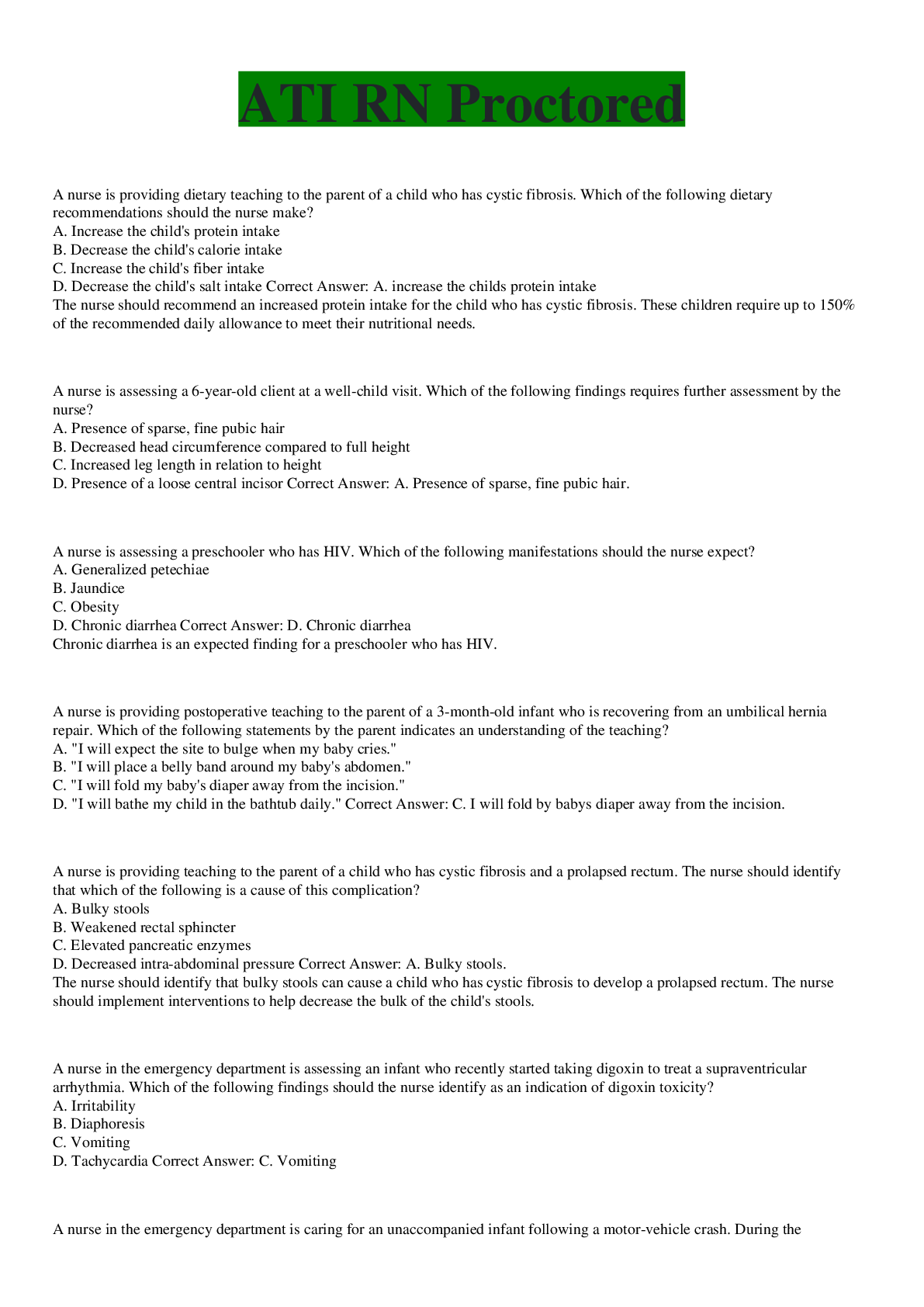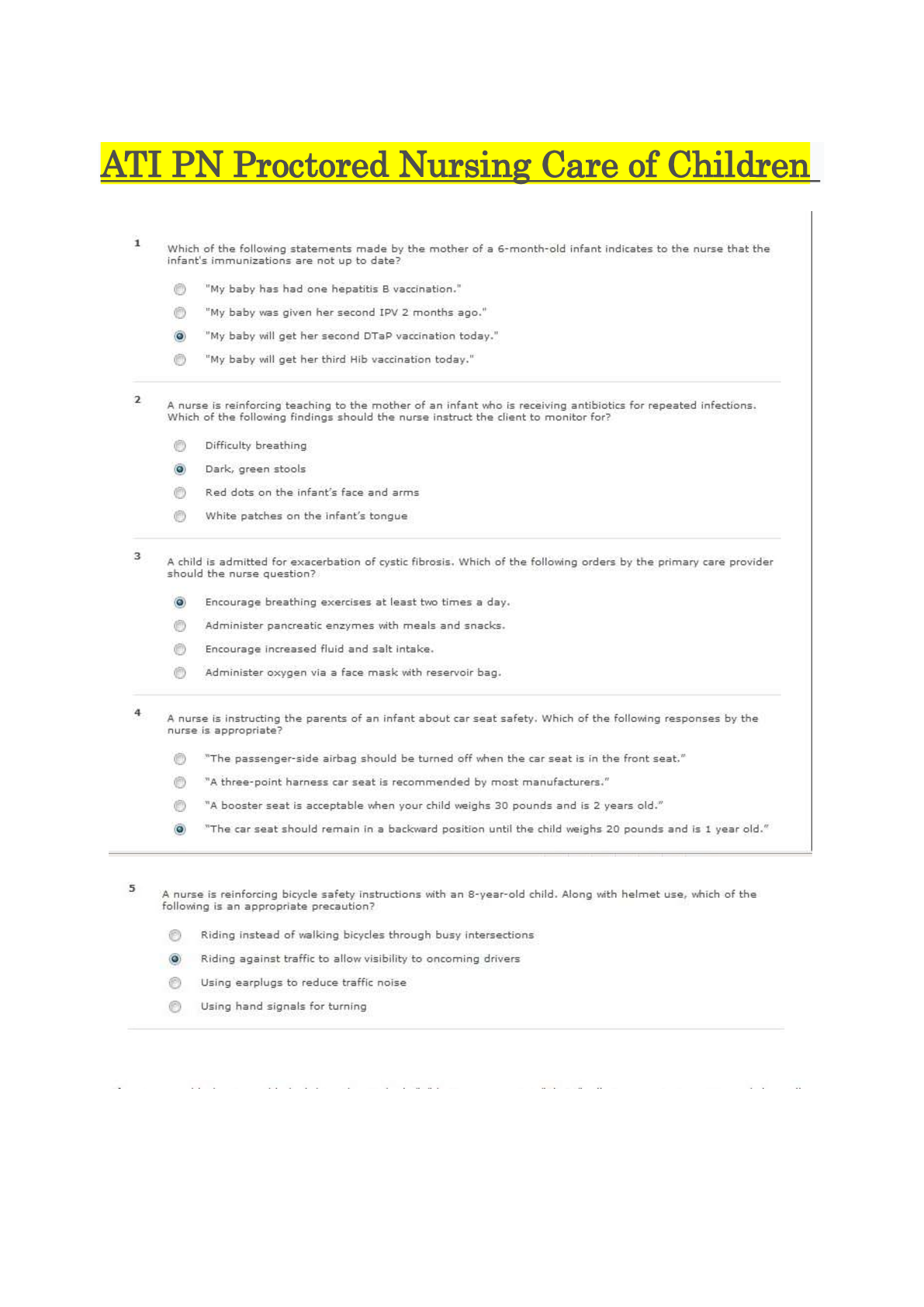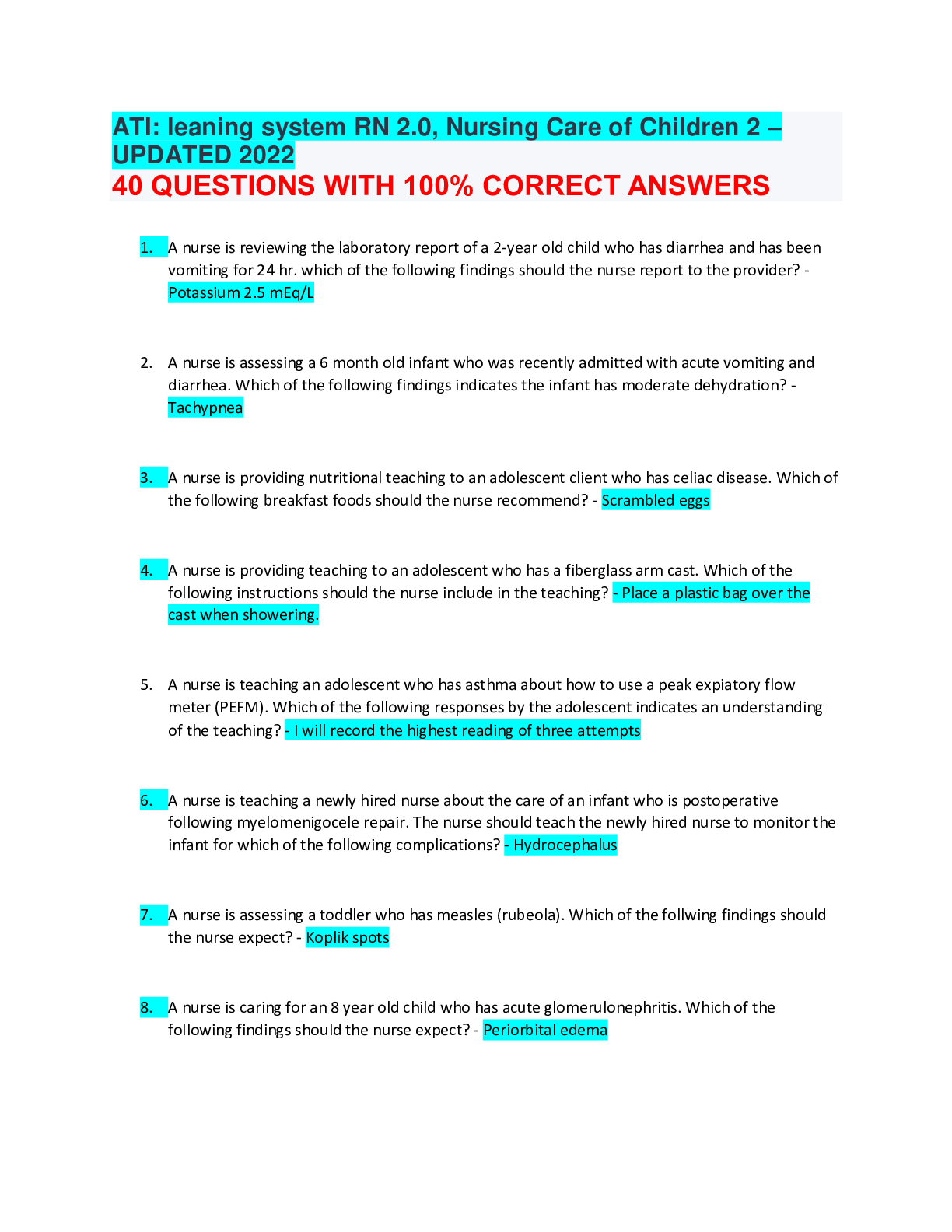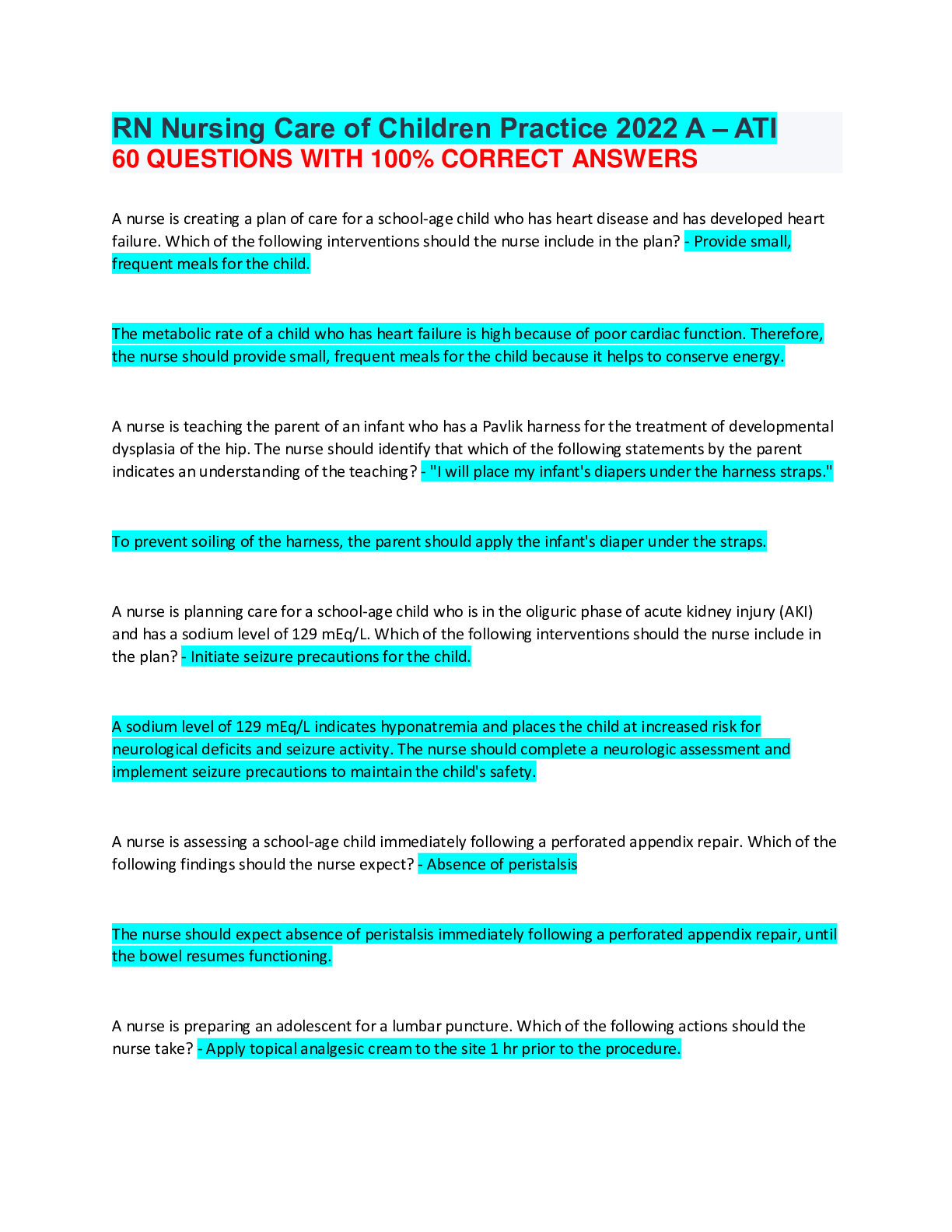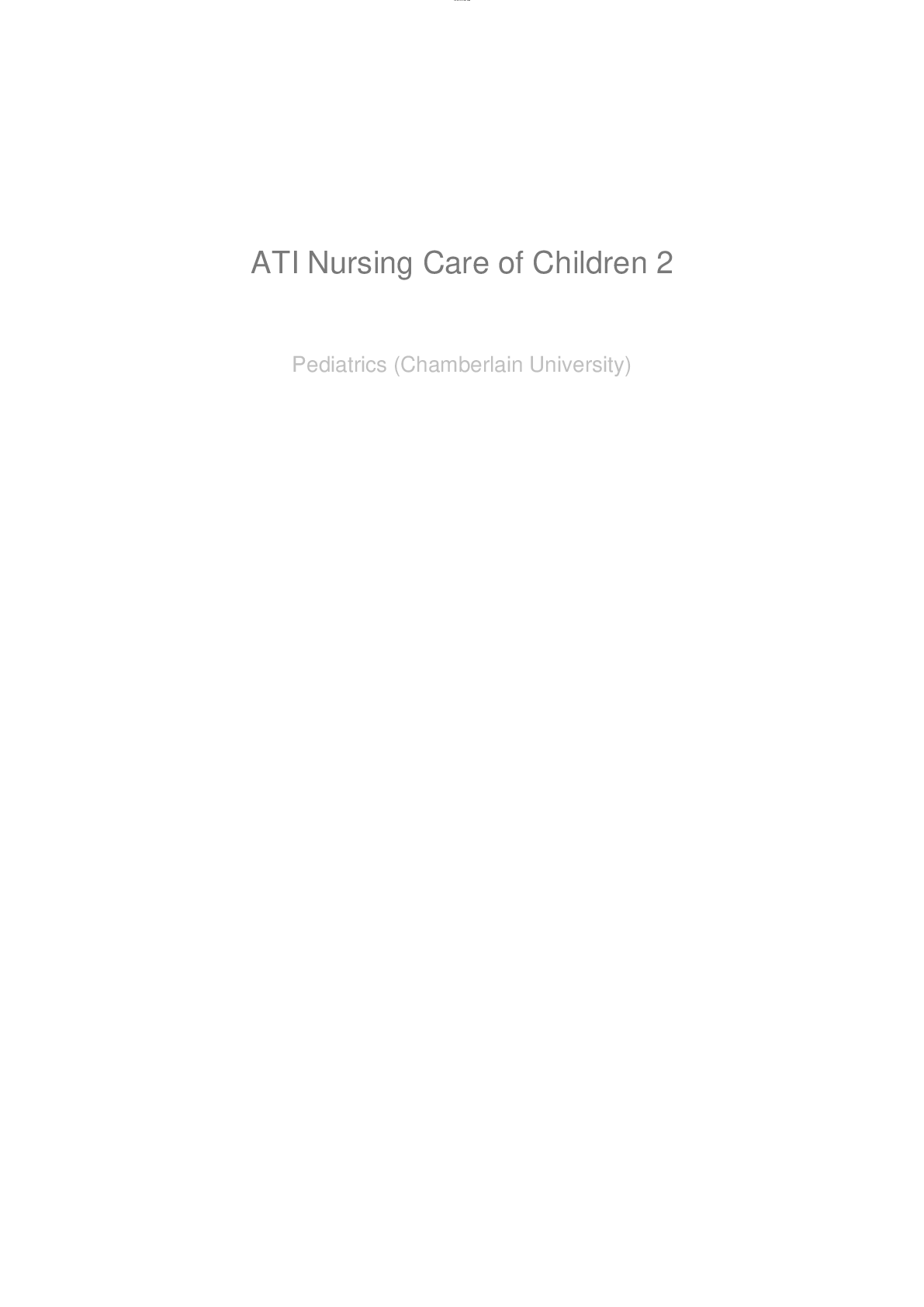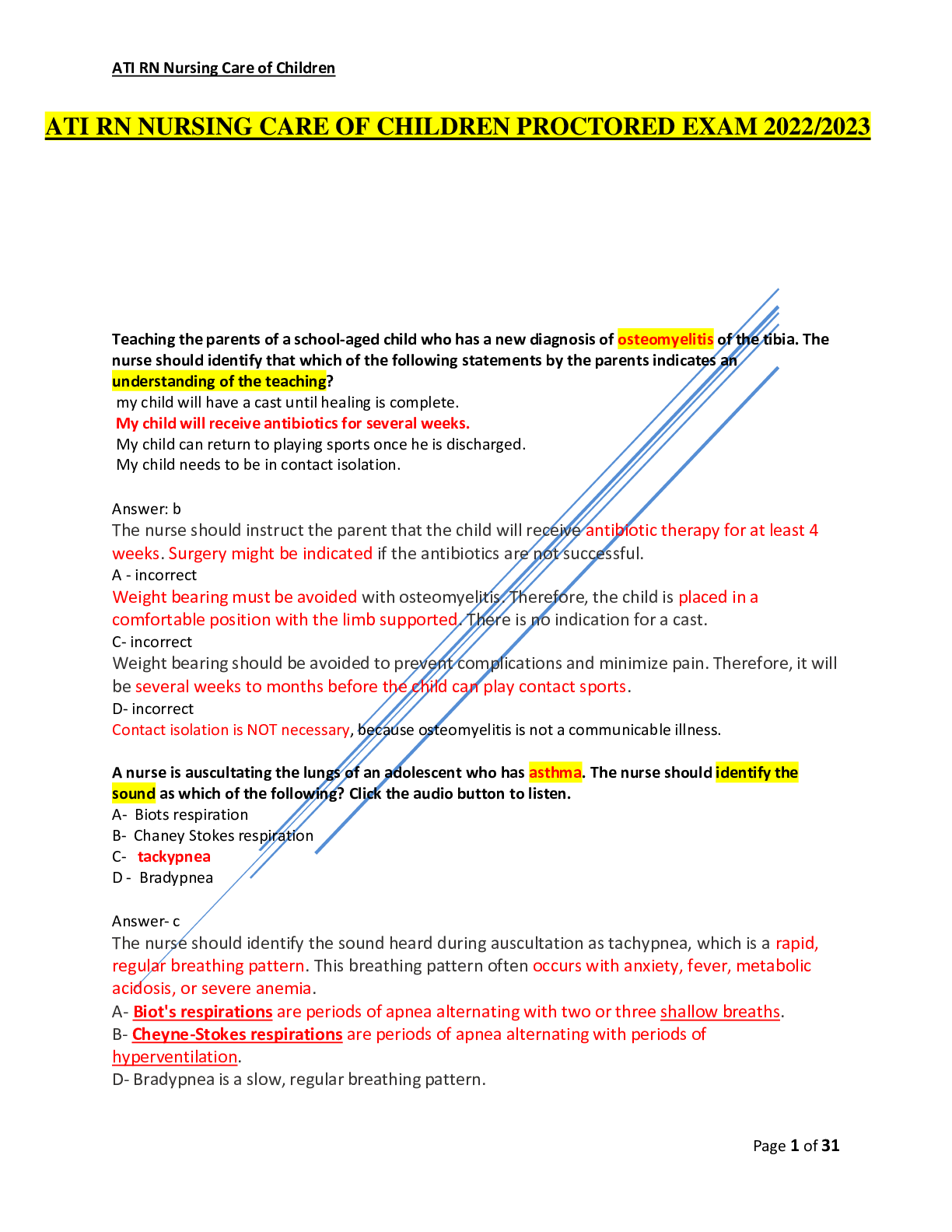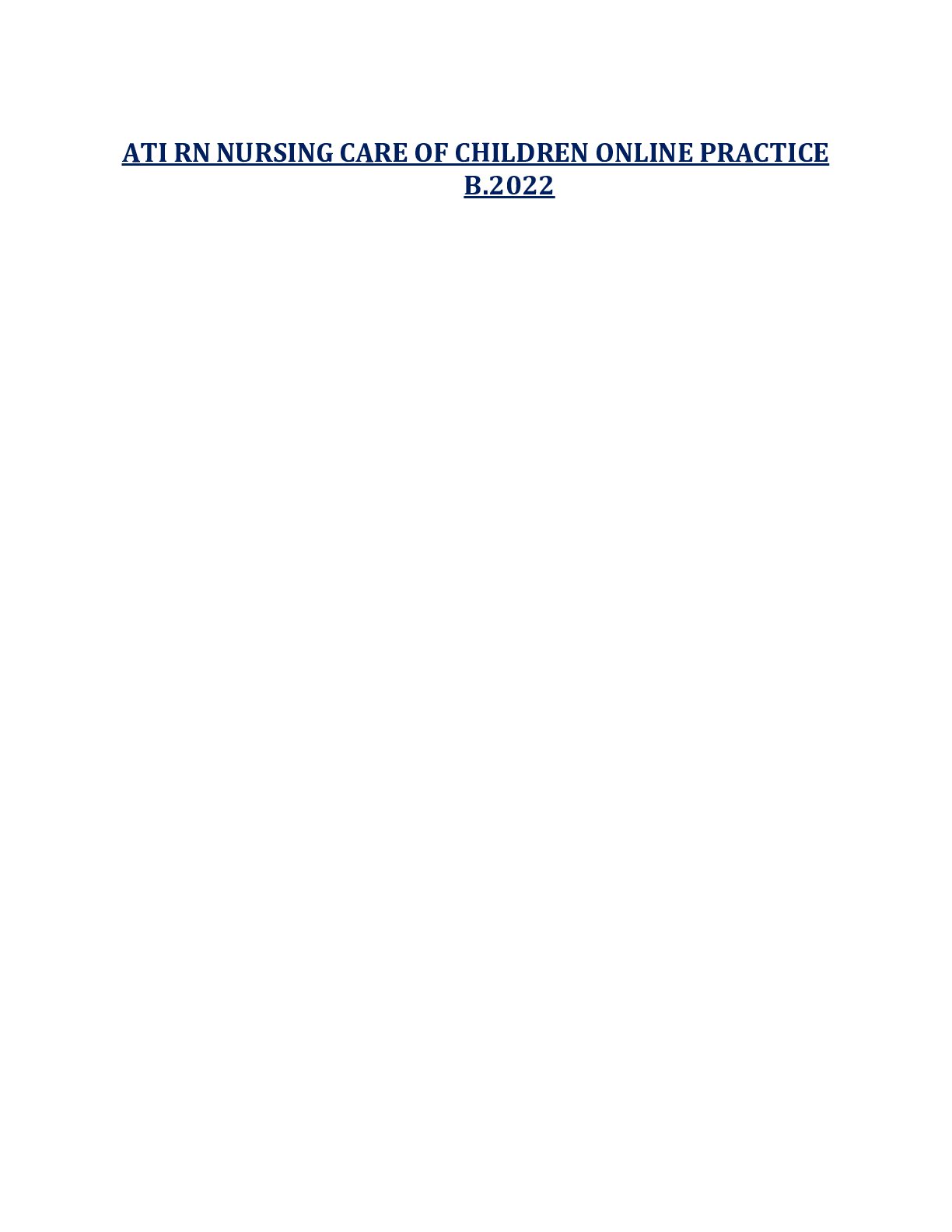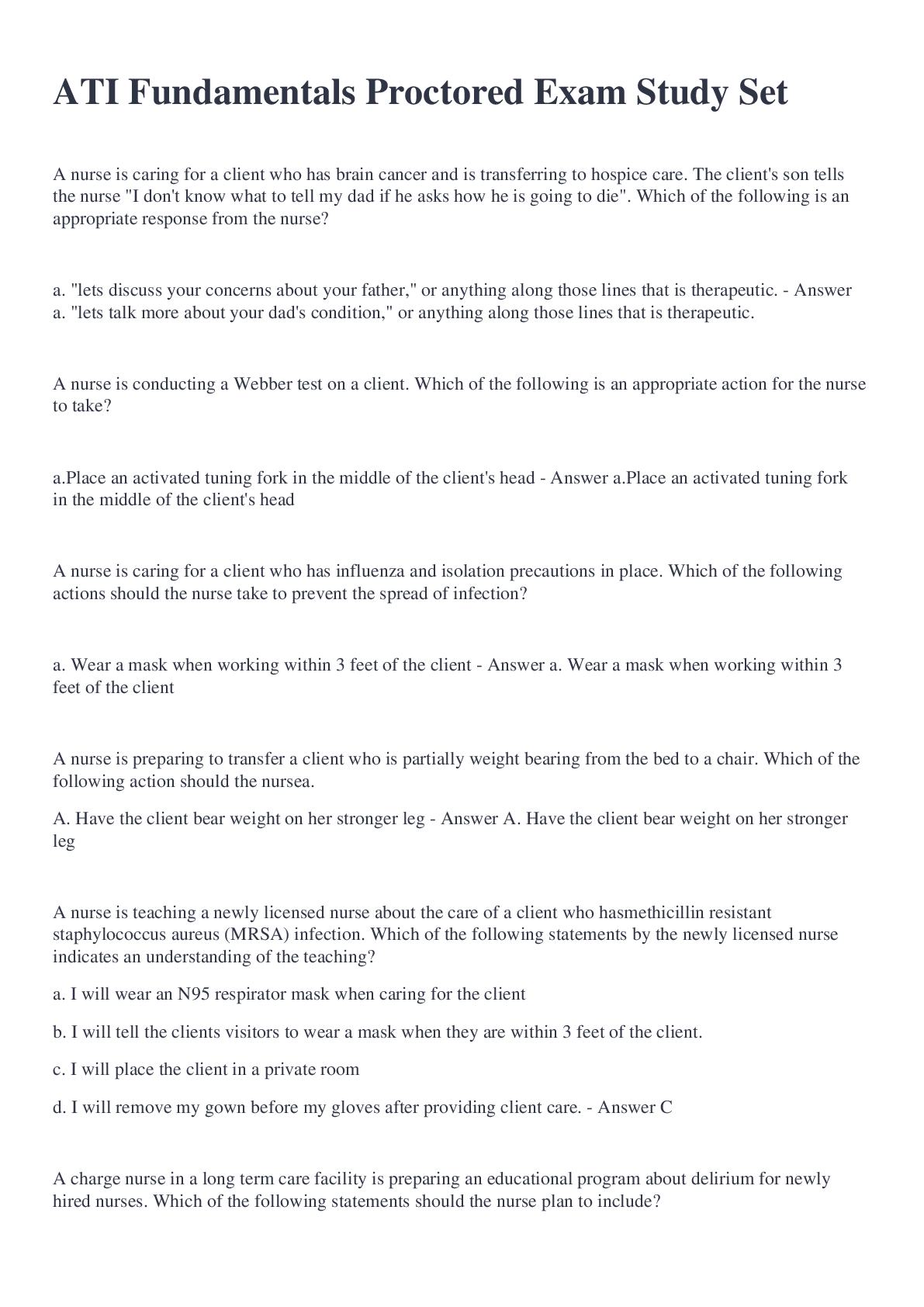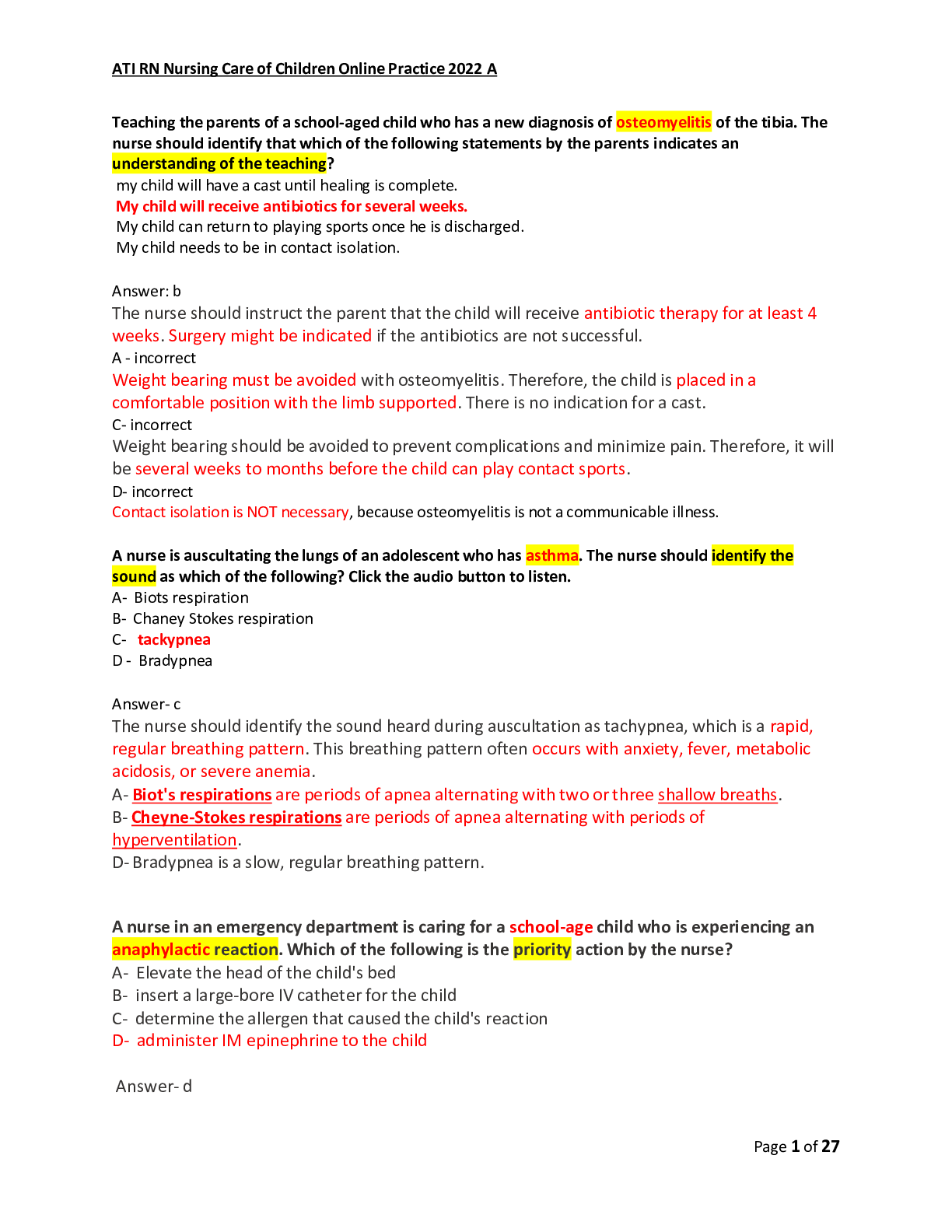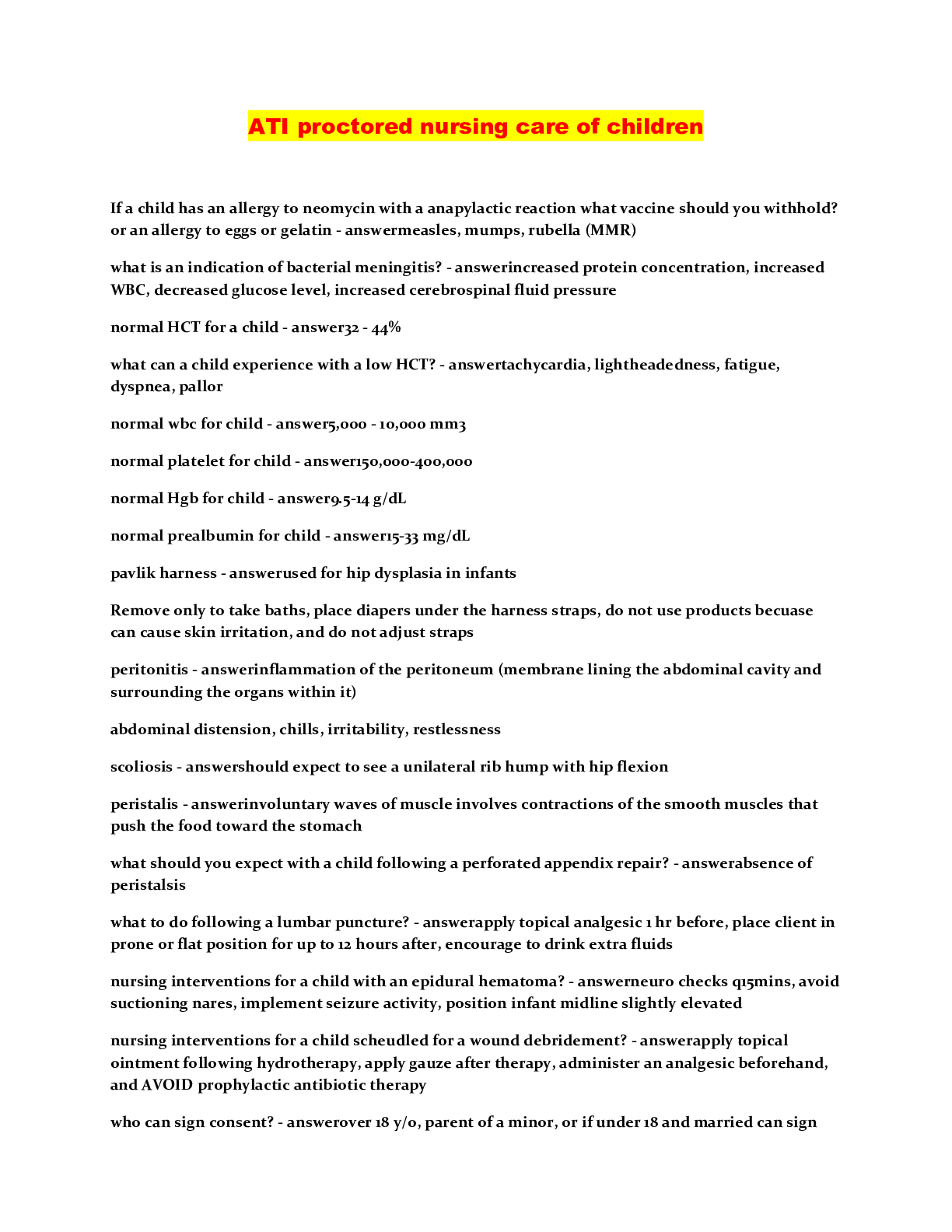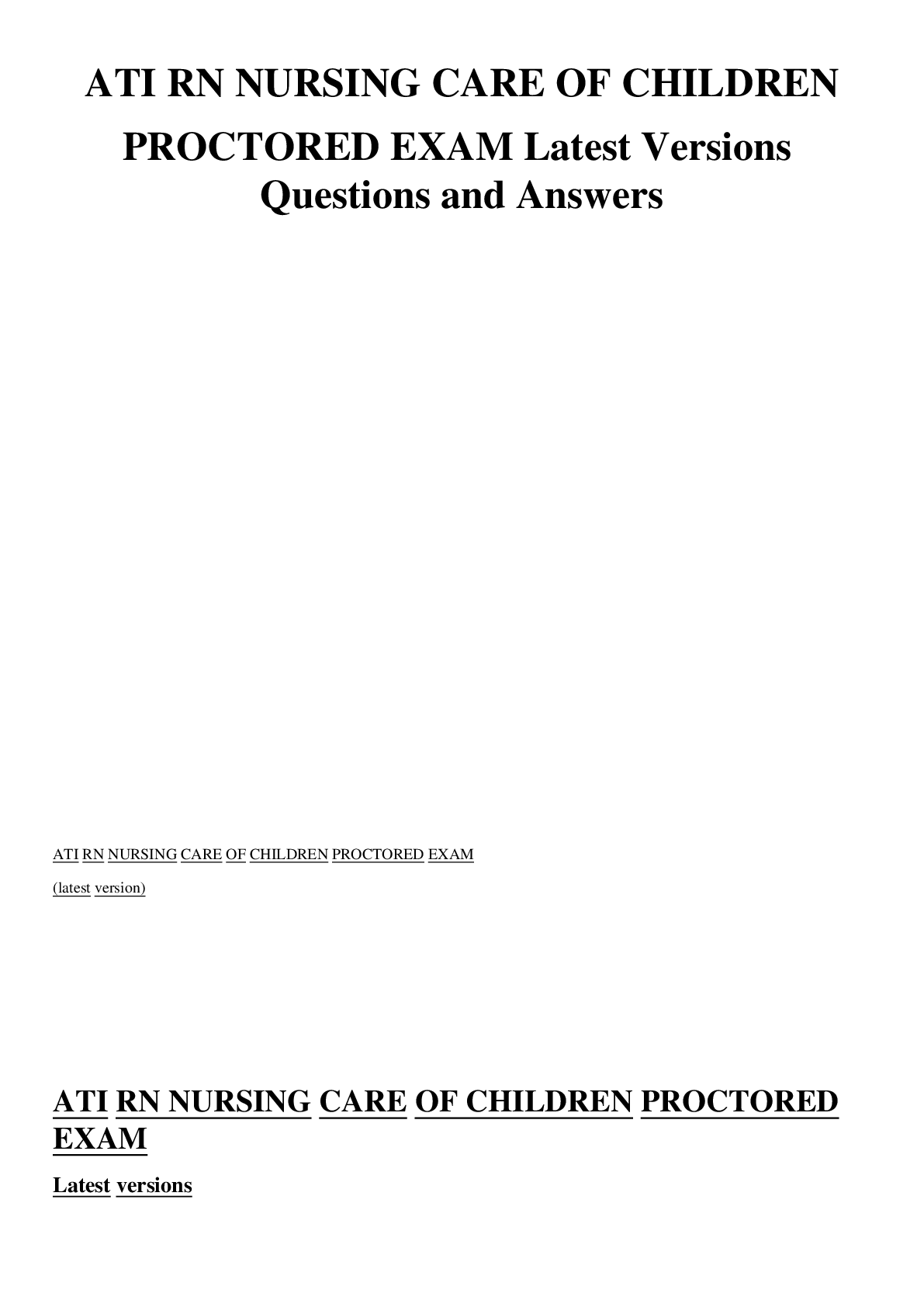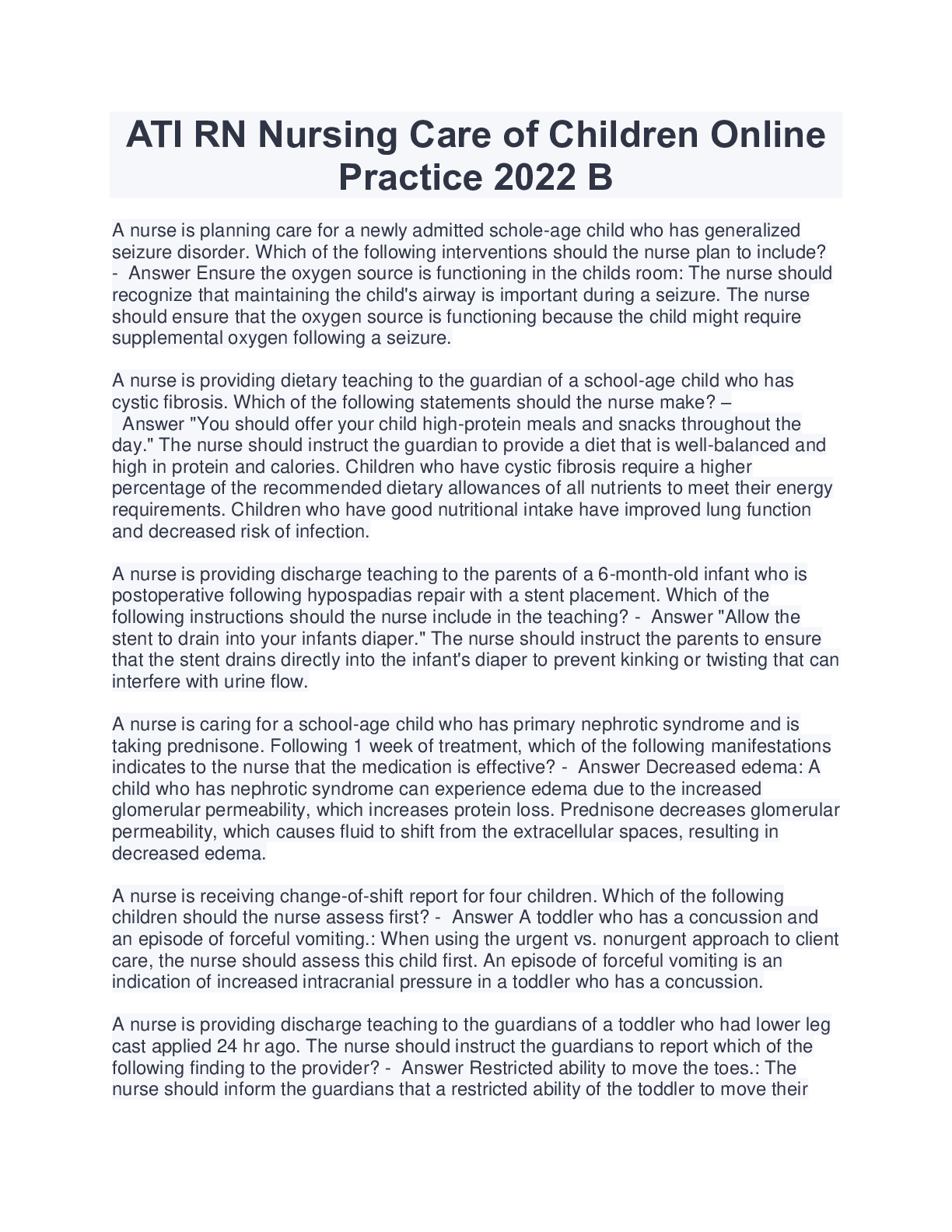*NURSING > ATI > ATI Nursing Care of Children Proctored Exam Study Guide Fall updated Summer 2022. (All)
ATI Nursing Care of Children Proctored Exam Study Guide Fall updated Summer 2022.
Document Content and Description Below
ATI Nursing Care of Children Proctored exam study guide Fall updated Summer 2022. What is a dictorial or authoritarian parenting style? *ANS- parents try to control the child's behaviors and atti... tudes through unquestioned rules and expectations What is an authoriatitive parenting style? *ANS- also known as democratic, parents direct the child's behavior by setting rules and explaining the reson for each rule setting What is passive parenting? *ANS- parents are uninvolved, indifferent, and emotionally removed A nurse manager on a pediatric floor is preparing an education program on working with families for a group of newly hired nurses. Which of the following should the nurse include when discussing the developmental theory? A. describes that stress is inevitable B. emphasizes that change with one member affects the entire family C. provides guidance to assist families adapting to stress D. Defines consistencies in how families change *ANS- D A nurse is assisting a group of parents of adolescents to develop skills that will improve communication. The nurse heads one parent states "my son knows he better do what I say". Which of the parenting styles is he exhibiting? A. Authoritarian B. Permissive C. Authroitative D. Passive *ANS- A A nurse is performimg family assessment. Which of the following should the nurse include? (select all that apply) A. medical history B. parents' education level C. child's physical growth D. Support systems E. Stressors *ANS- A, B, D, E What is the expected pulse rate of a newborn? *ANS- 80 to 180/min What is the expected pulse of a baby 1 week to 3 months? *ANS- 12 to 180/min What is the expected pulse of a child 3 months to 2 years? *ANS- 70 to 150/min What is the expected pulse of a child 2 to 10 years? *ANS- 60 to 110/min What is the expected pulse of a child 10 years and older? *ANS- 50 to 90/min What are the expected respirations fo a newborn to one year? *ANS- 30 to 35/min What are the expected respirations of a 1 to 2 year old? *ANS- 25 to 30/min What are the expected respirations of a 2 to 6 year old? *ANS- 21 to 25/min What are the expected respirations of a child 6 to 12 years old? *ANS- 19 to 21/min What are the expected respirations of a 12 year old and older? *ANS- 16 to 19/min What are the normal vitals of an infant? *ANS- HR: 80-180 RR: 30-35 BP: 65-80/40-50 Fontanels *ANS- should be flat and soft, posterior closes between 6 and 8 weeks, anterior closes between 12 and 18 months Teeth *ANS- 6 to 8 teeth by 1 year of age, 20 baby teeth and 32 permanent teeth How long is the Moro reflex present? *ANS- until 4 months of age How long is the Tonic neck reflex present? *ANS- until 3 to 4 months of age How long does the Babinski reflex last? *ANS- usually until a year Expected findings of the olfactory (I) nerve in infants , children, and adolescents *ANS- Infants: difficult to test Children and Adolescents: indentifies smell through each nostril individually Expected findings of optic nerve (II)? *ANS- Infants: looks at face and tracks with eyes Children and adolescents: has intact visual acuity, peripheral vision, and color vision Expected findings for trigeminal nerve? *ANS- infants: has rooting and sucking relfex children and adolescents: is able to clencg teeth together and can detect touch on face with eyes closed A nurse is preparing to assess a preschool-age child. Which of the following is an appripirate action by the nurse to prepare the child? A. Allow the child to role play using miniature equipment B. use medical terminology to describe what will happen C. separate th child from her parents during examination D. keep medical equipment visible to the child *ANS- A A nurse is checking the vital signs of a 3-year-old during a well child visit, which of the following findings should the nurse report to the provider? A. temperature 37.2C (99.0F) B. Heart rate of 106/min C. Respirations 30/min D. Blood pressure 88/54 mmHg *ANS- C A nurse is assessing a child's ears. Which of the following is an expected finding? A. Light reflex is located at the 2 o clock position B. Tympanic membrane is red in color C. bone landmarks are not visible D. Cerumen is present bilaterally *ANS- D A nurse is assessing a 6-month-old infant. Which of the following reflexes shoudl the infant exhibit? A. Moro B. Plantar grasp C. Stepping D. Tonic necl *ANS- B A nurse is performing a neurological assessment on an adolescent. Which of the following is an appropriate reaction by the adolescent when the nurse checks the trigeminal cranial nerve? (select all that apply) A. clencing the teeth together tightly B. recognizing a sour tast C. identifying smells through each nostril D. detecing facial touches when eyes closed E. Looking down and in with the eyes *ANS- A, D What happens to a baby's birth weight? *ANS- it should double by 6 months and triple by 1 year How do infants grow? *ANS- 1 inch per month (2.5cm) for 6 months, then by 12 months, height/length should be doubled When do the first teeth arupt? *ANS- between 6 and 10 months Gross and fine motor by 3 months *ANS- only have slight head lag Gross and fine motor by 4 months *ANS- should be able to roll from back to side Gross and fine motor by 5 months *ANS- should be able to roll from front to back Gross and fine motor by 6 months *ANS- should be able to roll from back to fron and hold a bottle Gross and fine motor by 7 months *ANS- move object from hand to hand Gross and fine motor by 8 months *ANS- sit unsupported Gross and fine motor by 9 months *ANS- crude pincer grasp Gross and fine motor by 10 months *ANS- prone to sitting positiion and grasp a ratty by the handle Gross and fine motor by 11 months *ANS- puts objects into a container and have a neater pincer grasp Gross and fine motor by 12 months *ANS- tries to build a 2 block tower and won't succeed What Piaget congitive development stafe are infants in? *ANS- Sensorimotor stage, birth to 24 months, separation, object permanence around 9 months, mental representation How many words should the infant know? *ANS- 3-5 words and has concept of numbers by 1 year What is the Erikson's stage of development for infants? *ANS- Trust vs. Mistrust, birth to 1 year, caretake meeteing the needs of the infant When does separation anxiety begin to occur? *ANS- between 4 and 8 months When is there stranger fear in infants? *ANS- 6 to 8 months What toys should be used for an infant? *ANS- rattles, blocks, brightly colored toys, mirrors, patty cake Infant Immunizations *ANS- Birth: hep B 2 months: hep B, IPV, RV, PCV, dtap, HIB 4 months: all of the 2m, hep B 6 month: all the previous Flu shots: 6m to 1 year Infant Nutrition *ANS- breast milk first 6 months, solids 4 to 6 months and first solid is usually iron fortified rice ceral, no juice or water is needed for first year, foods introduced one at a time over 4-7 day period to monitor for allergies What are infant safety concers? *ANS- choking/aspiration (grapes, coins, candy) burns (sunscnreen, handles turned away from stove, electrical outlets are covered), drowning, rear facing care seat until 2 years, crib slats are no more than 6cm, no pillows, and sleep on back A nurse is assessing a 12 months old infant during a well-child visit. Which of the following findings should the nurse report to the provider? A. closed anterior fontanel B. eruption of 6 teeth C. Birth weight doubled D. Birth length increased by 50 % *ANS- C A nurse is performing a developmental screening of a 10-month old infant. Which of the following fine motor skills should the nurse expect to find? (select all that apply) A. grasp a raddle by the handle B. try building a two-block tower C. use a crude pincer grasp D. Place objects into a container E. Walkes with one hand held *ANS- A, C A nurse is conducting a well-baby visit with a 4 motnh old infant. Which of the following immunizations should the nurse plan to administer? (select all that apply) A. MMR B. IPV C. PCV D. varicella E. RV *ANS- B, C, E A nurse is providing education about introducing new foods to the parents of a 4 months old infant. The nurse should recommend that the parents introduce which of the following foods first? A. Strained yellow vegetables B. Iron fortified cereals C. Pureed foods D. Whole Milk *ANS- B A nurse is providing teaching about dental care and teething to the parent of a 9-month-old. Which of the following statements by the parent indicates an understanding of the teaching? A. I can give my baby a warm teething ring to relieve discomfort B. I should clean my baby's teeth which a cool, wet washcloth C. I can give Advil for up to 5 days while my baby is teething D. I should place diluted juice in the bottle my baby drinks while falling asleep *ANS- B Weight gain of todder *ANS- 4x their birth weight by 30 months Height gain of toddler *ANS- 3 inches per year (7.5cm) Head and chest growth of toddler *ANS- head and chest circumference are abotu equal, compared to when they are born, and their head is wider than their chest gross and fine motor skills of a 15-month toddler *ANS- expect walking without help, should be able to build a 2 block tower gross and fine motor skills of 18-month toddler *ANS- can throw a ball over head gross and fine motor skills of 2 year old toddler *ANS- can walk up and down stairs by placing feet on each step and build a 6-7 block tower gross and fine motor skills of 2.5 year old toddler *ANS- can jump with both feet and draw circles Language of a toddler *ANS- 1 year = 1 word senteces/hollow phrases 2 year = 2-3 word senteces Erikson's stage of Toddlers *ANS- autonomy vs shame and doubt, independence, begin to express selves by saying no a lot, thrive on rituals, maintian routines Toddler appropirate activities *ANS- blocks, push pull, thick crayons, puzzle Bathroom needs of toddlers *ANS- toilet training begins when they have recognized the sensation that they need to go potty Immunizations of a toddler *ANS- 12-15 month: IPV, PCV, MMR, varicells, HIB 12-23 months: Hep A 2 doses 6 months apart 15-18months: dtap and annual flu Nutrition of a toddler *ANS- breast milk or formula through 1 year, 1-2 year whole milk, after 2 can transition to low fat, limit juice consumption to 4-6oz per day, prevent choking, nuts, grapes, hot dogs, peanut butter, raw carrots, tough meat, popcorn What are safety hazards of toddlers? *ANS- burns, drowning, falls, aspiration, prevention A nurse is assessing a 2.5-year-old toddler at a well-child visit. Which of the following findings should the nurse report to the provider? A. height increased by 7.5cm or 3inches in the past year B. Head circumference exceeds chest circumference C. anterior and posterior fontanels are closed D. current weight equals four times the birth weight *ANS- B A nurse is performing a develomental screening on an 18 month old. Which of the following skills should the toddler be able to perform? (select all that apply) A. build a tower with 6 blocks B. Throw a ball overhead C. walk up and down stais D. draw circles E. use a spoon without rotation *ANS- B, E A nurse is providing teaching about age-appropriate activities to the parent of a 2 year old. Which of the following statemetns by the parent indicates an understanding of the teaching? A. I will send my child's favorite studdef animal when she will be napping away from home B. My child should be able tot stand on one foot for a second C. The soccer team my child will be playing on starts next week D. I should expect my child to be able to draw circles *ANS- A A nurse is providing anticipatory guidance to the parents of a toddler. Which of the following should the nurse include? (select all that apply) A. Develop food habits that will prevent dental caries B. Metting caloric needs resulting in an increased appetite C. expression of bedtime fears is common D. Expect behaviors associated with negativism and ritualism E. Annual screenings for phenylketonuria are important *ANS- A, C, D Growth of preeschoolers *ANS- 4.5-6.5 pounds per year 2.3-3.5 inches per year or 6-9cm Gross motor skills of 3 year old preeschooler *ANS- can ride tricycle and jump off bottom step on stairs Gross motor skills of 4 year old preschooler *ANS- can skip and hop on one foot and throw the ball over head Gross motor skills of 5 year old preschooler *ANS- can jump rope Cognitive development of the preschooler? *ANS- Piaget, preoperational phase 4-7 years, moving from preconceptual phase to the phase of intuitive thought, magical thinking, animisim, centration, time Erikson, initiative vs guilt Regression *ANS- in preschoolers, another baby in the family can cause the preschooler to regress to bed wetting or thumb sucking, to be expected What are appropirate activities for a preschooler? *ANS- playing ball, puzzles, tricyles, dress up, role playing Immunizations of preschooler *ANS- 4-6 years, dtap, mmr, IPV and annual flu What does the sleep schedule of a preschooler look like? *ANS- 12 hours of sleep, bedtime routine Teeth of preschooler *ANS- eruption of primary teeth is finalized by the beginning of the preshool years What may be a safety initiative for preschooler? *ANS- protective gear with tricycles A nurse is providing teaching to the parent of a preschool age shcil about methods to promote sleep. Which of the following statements by the parent indicated an understanding of the teaching? A. I wil sleep in the bed with my child if she wakes up during the night B. I will let my child stay up and additional 2 hours on weekend nights C. I will et my child watch television for 30 minutes nust before bedtime each night D. I will keep a dim lamp on in my child's room during the night *ANS- D A nurse is conducting a well child visit with a 5 year old child. Which immunizations shoudl the nurse plan to administer to the child? (Select all that apply) A. DTaP B. IPV C. MMR D. PCV E. Hib *ANS- A, B, C A nurse is preparing an education program for a group of parents of preschool-age children about promoting optimum nutrition. Which of the following information should the nurse include in the teaching? A. saturated fats should equal 20% of total daily caloric intake B. Average calorie intake should be 1800 calories per day Continues>>>>>>>>>>>>>>>>>>>>>>>>>>>>>>>>>>>>>>>>>>>>>>>>>>>>>>>>>>>>>>>>> [Show More]
Last updated: 8 months ago
Preview 1 out of 39 pages

Reviews( 0 )
Document information
Connected school, study & course
About the document
Uploaded On
Jun 27, 2022
Number of pages
39
Written in
Additional information
This document has been written for:
Uploaded
Jun 27, 2022
Downloads
1
Views
256

